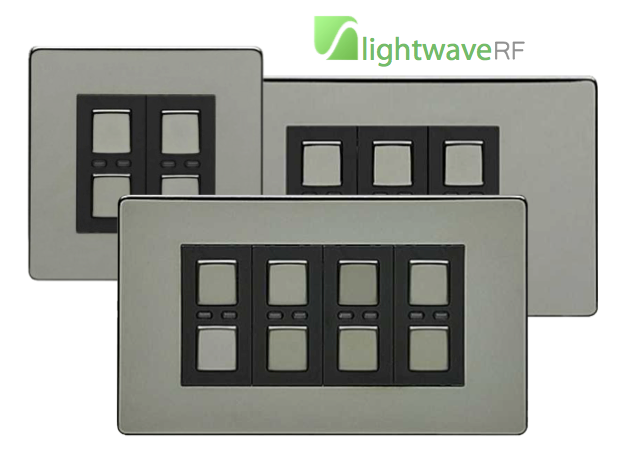Taking the LightwaveRF out of LightwaveRF
Ultimately this is the story of how I got my Home Automation to the point where Amazon Alexa (on multiple Echo Dots) can control lights, switches, curtains and the heating in my house via voice control. But this is a journey that starts three years ago, in the summer of 2013, when we moved house and I splurged on new light switches…
Among the not insignificant number of gaps in my posting history on this site is an entire year where I posted nothing: 2013. That’s a shame because it is a year where I did quite a lot of interesting technical stuff around the home. We moved to the house in Finchampstead in the summer of 2013 and one of the first things I did was replace every light switch in the house with LightwaveRF switches. The LightwaveRF line of products is possibly the most cost effective, and certainly one of the easiest ways to retrofit home automation for switches, dimmers and sockets. In most cases you can simply remove and replace the existing light switch – it gets more complex with multi-way switching, but is still all very achievable for anyone comfortable with simple home electrics.

So having kitted out the house with switches that can be triggered via wireless remotes, “mood” controllers and various other hardware, the next step was to use the LightwaveRF WifiLink device to allow smartphone control. This is a curiously named device. “Wifi” is misleading since it connects via an ethernet cable into the rest of the network and has no true Wifi capability. Once plugged in this allows a smartphone to talk to the Link, and the Link to send RF commands to the other devices. They’ve changed the design of the device since I used it – the old one is pictured here.

One of the downsides of the LightwaveRF devices – and probably a reason they’re considerably cheaper than their competitors – is the quirky way you add them to the system. The device is put into pairing mode via a sequence of button presses, then the controlling device – in this case the WifiLink – sends a command which the receiving device “learns”. There is no return path, and the controller has no way of knowing the current status of any device. In effect, there is no “system” as such, just a load of independent devices that know nothing about any other device except the controller they’ve learned. This keeps the cost down since the switches themselves only have to have an RF receiver and no mechanism for transmitting anything.
This means to build your Home Automation with Lightwave you must visit every device in the house, press the magic button sequence, press the send button on the controller app and watch the device confirm it learned the sequence. That was fine, if fiddly, the first time I had to do it. Sadly, both the WifiLink hardware itself, the smartphone apps and especially the cloud-based services that support them, were a little flaky to start.
At one point Lightwave transitioned from one backend system to a new one. This wasn’t handled terribly well and like a lot of people I lost the settings in my account and had to reprogram the house. Yes, that meant revisiting every device in the house to put it in learn mode and re-send the commands. Note to potential purchasers: placing LightwaveRF devices in hidden or hard to access locations will come back to haunt you.

The third time this happened, I stopped adding devices to the WifiLink device in favour of using a Raspberry Pi running a fantastic bit of software called Domoticz with a very handy USB device called the RFXCOM. Domoticz has an API, can call into other systems, is fully scriptable and has complex timers and scene building out of the box. The RFXCOM is a transceiver capable of transmitting and receiving dozens of different RF protocols to control many home automation systems. It’s like the C3PO of home automation. One of the languages it speaks is LightwaveRF, and another advantage is a much better range than the standard Lightwave controller. I kept the WifiLink controller connected, but transitioned nearly every device to Domoticz and the RFXCOM.
We’ve also kept the LightwaveRF remotes – neat little handheld controllers that can trigger one or more other devices. We also kept the motion sensor to automatically turn on the kitchen lights – more on these sensors and what we replaced them with later.
Through 2013 and over the last few years I’ve progressively tweaked the system and learned a lot about what works and what doesn’t, so in future posts, which get a bit more technical:
- introducing Samsung SmartThings
- connecting SmartThings to Lightwave devices via some Pi-based scripts
- how to kill an SD card on a Pi, and how to prevent it happening
- nomenclature fun and games with the SmartThings Alexa skill
- a (brief) return to the WifiLink when it introduced Alexa support
- removing the WifiLink entirely and controlling Domoticz via SmartThings
- improved motion sensor behaviour via SmartThings
- using node.js on Pi to control Sonos
- using Python to query and control Honeywell Home heating
- adding home media control via the Logitech Harmony Hub
Enjoy Reading This Article?
Here are some more articles you might like to read next: